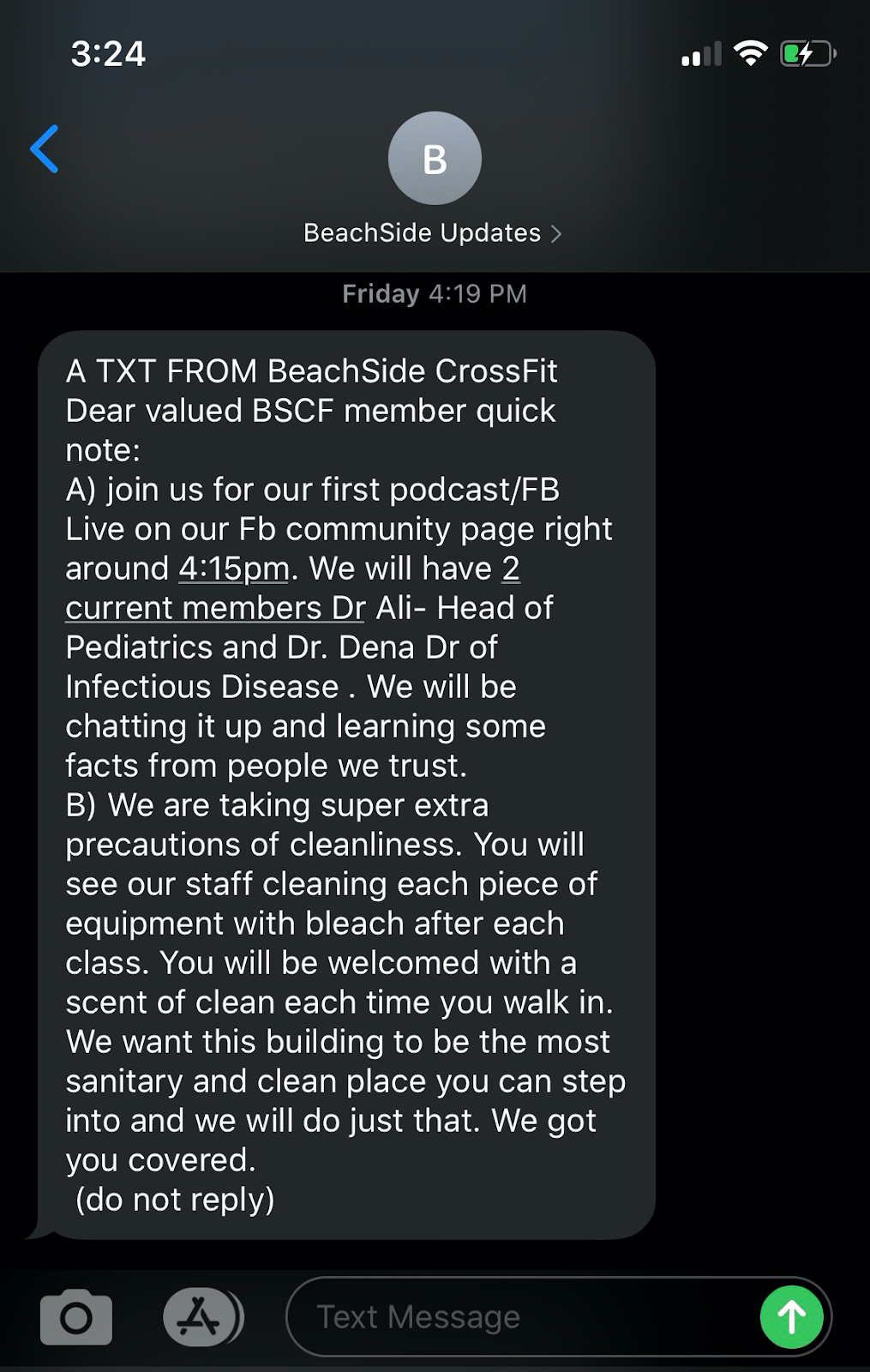SMS marketing 101: How to use text messaging in your marketing strategy
Looking to tap into the marketing strategy that gets 4x more open rates than email?
It’s something 6.57 billion people are already using, and one of the best ways to get your message across in the digital age. It’s SMS marketing—one of the easiest and most effective ways to reach your target audience.
In this post, we’ll take a look at what SMS marketing is, different types of SMS marketing campaigns and share some examples of how businesses are using SMS marketing to reach their goals.
What is SMS marketing?
SMS marketing (or “text marketing”) is a form of mobile marketing that allows businesses to send text messages to customers and prospects. These messages can be anything from promotional offers and discounts, to appointment reminders and shipping notifications.
Marketing by SMS has several advantages over other mobile marketing strategies like email marketing and push notifications. For one, SMS messages have a nearly 100% open rate, which means your audience is much more likely to see your text message than your email (average open rates for emails are around 22%).
SMS marketing is a great way to reach your target audience with a concise and clear message. For example, if you’re running a weekend sale or promotion, you can let your customers know via text. Or, if you own a restaurant, you can send SMS messages with your daily specials.
Types of SMS marketing campaigns
There are many types of SMS marketing campaigns, from simple and straightforward to more complex.
Here are two of the most effective forms:
Promotional campaigns
Promotional SMS marketing campaigns are designed to generate interest in a product or service. They can include discounts, coupons and other special offers.
Coupons and promotions can be an excellent way to drive more people to your store or website, especially when accompanied by a quality call to action (CTA). Here’s an SMS marketing example from fashion brand Jenni Kayne, which includes a personalized coupon code and a direct link to their shop page:

Transactional campaigns
Transactional SMS marketing messages are sent in response to an event or action. These campaigns offer information that is time-sensitive and relevant to the customer, such as appointment reminders, shipping notifications or password resets. Because these messages are so timely and relevant, they have a high open-rate and can be very effective in driving conversions.
An example of a transactional SMS campaign is an order confirmation from an ecommerce purchase. Here’s an example from Baking Steel that includes order confirmation, tracking information and an unsubscribe option.

Why do businesses use SMS marketing?
Did you know 75% of consumers are comfortable getting SMS messages from brands, as long as they opt-in?
SMS business marketing reaches your target audience with timely and relevant information that can help increase brand awareness and boost engagement.
Here are just a few ways you can use SMS marketing for your business:
Reach customers faster
If you have time-sensitive information to share, SMS is the right medium, as 90% of text messages are opened within three minutes of receipt.
For example, if you’re running a limited-time offer, you can use SMS to let your customers know.
Increase response rates
Unlike other marketing channels, SMS allows you to reach your customers directly on their mobile devices. Because of this, text messages have a much higher response rate than other marketing channels. Response rates can help keep your customers engaged with your SMS marketing and open opportunities for further offers.
To increase response rates, try including a CTA in your text messages to encourage customers to take the next step. For example, you could include a CTA like “Reply YES to RSVP,” or “Click the link to learn more.”
Complement other marketing channels
While an SMS marketing strategy is strong on its own, it can also be used to enhance other marketing channels. For example, you could use SMS to promote a contest or sale on social media or include a link to an email newsletter in your text messages. You could also use SMS to remind customers of an upcoming event or webinar, in order to increase signups.
Build customer loyalty
SMS marketing can build loyalty with your customers, as it allows you to send personalized messages and offers to individuals. This is a great way to make your customers feel valued, and increase the chances of them returning to your business in the future.
Increase revenue
SMS marketing can help you increase revenue by driving traffic to your store or website. You can use SMS messages to promote special sales and events and include a call to action that encourages customers to take advantage of the offer. You could also use SMS messages to remind customers about items they’ve left in their shopping cart, encouraging them to complete their purchases.
SMS marketing strategies (with examples)
Ready to ramp up your SMS marketing? Here are some creative SMS marketing strategies, along with examples, to get you started:
Send welcome messages to new subscribers
Once a customer subscribes to your SMS marketing campaign, send them a welcome message! This will ensure they know they’re subscribed, and it will give you an opportunity to engage with them right away. Plus, it sets the tone for future interactions.
Welcome messages don’t have to be long or complex. A simple, “Thank you for subscribing!” will do. You could even include a coupon code or special offer to sweeten the deal.

Announce new product releases
Another smart use of SMS advertising is to announce new product releases. If you’ve got a new product or service you’re excited about, let your subscribers know as soon as (or before) it’s available.
This is a great way to generate buzz and interest, and it might even encourage customers who haven’t purchased from you in a while to come back and check out what’s new.
You can also try driving traffic to your website or storefront by including a link in your SMS campaign. For example, text “Check out our new arrivals!” and include a link to your website or online store. This can boost traffic and give people a reason to visit your site.

Follow up on abandoned shopping carts
The average cart abandonment rate for e-commerce businesses is 69.82%. That’s a lot of potential revenue that’s left on the table!
SMS marketing can help you recover some of that lost revenue, by sending abandoned cart messages to customers who have left items in their online shopping carts.
Here’s an SMS marketing example from CB2, a home furnishings retailer.

Inform customers when products are back in stock
One of the most frustrating things for customers is discovering an item they want to buy is out of stock. With SMS marketing, you can notify customers as soon as products are back in stock, so they can buy them before they sell out again. You can also let customers know when products they may be interested in are about to go on sale.

Collect customer feedback
Customer feedback is essential for businesses to understand what they’re doing well and where they need to improve. SMS surveys collect customer feedback quickly and easily.
You can use tools like Google Forms or SurveyMonkey to create a short survey, then send the link through SMS. Or, simply ask a customer to reply to your text with a rating from one to five, then follow up with any customers who give a low rating to find out what you can improve.

Provide text-based customer service
You can use text messages to provide customer service. This is especially useful for businesses that have a mobile workforce, like plumbers or delivery drivers.
If a customer needs to get in touch with someone, they can simply send a text rather than having to make a phone call. This can save the customer time, and it can also be less disruptive for the business.
Here’s an SMS marketing example from U-Haul, which offers customers the opportunity to check-in and out via text:

Ask for production or service reviews
Many companies use SMS marketing to gather reviews about their service or staff. You’ve probably seen this from companies like Uber, which ask customers to rate drivers after their ride. Asking for customer reviews is an effective way to get feedback on their experience and identify areas that need improvement.
According to The Nielsen Company, 92% of consumers trust recommendations from family, friends and other customers. So, consider displaying these reviews on your website or social media pages, as well as in your SMS marketing messages.
Promote online and in-person events
Promoting your upcoming events through SMS marketing can help get people excited and engaged.
Your SMS event reminders can include:
- Date, time and location of your event
- A CTA to encourage people to buy tickets or sign up
- A link to your website or event page
- Details about what attendees can expect
- Hashtags to promote on social media
- Emojis to increase engagement
If you have a limited number of spots available, be sure to include an RSVP link in your text so subscribers can reserve their spots right away.

Start a VIP program
A VIP program encourages loyalty among your customers and subscribers. People love to feel like they’re part of an exclusive group, so make them feel special by offering VIP-only discounts, early access to sales and new products and other benefits.
To promote your VIP program, include a signup link in your SMS messages when customers purchase a product. You can also promote your VIP program on social media, on your website or in-store.
Make sure you’re using an SMS marketing service that allows you to segment your list so you can send different messages to your VIPs and general subscribers.
Segmenting your list ensures you’re sending the most relevant messages to each group, which leads to higher engagement and conversions.
4 SMS marketing best practices to follow
Now that we’ve gone over how to do SMS marketing for your business, let’s take a look at some best practices you should follow to get the most out of your campaigns.
1. Only send texts to those who opted in
Only send texts to those who have explicitly given you permission to do so. The best way to do this is to include an opt-in form on your website or other online channels.
Even if you have an opt-in, it’s a good idea to send an initial text thanking a new subscriber and asking them to confirm opt-in with a simple reply of “Yes” or “No.”

2. Make it easy for customers to opt-out
Make it easy for customers to stop receiving texts from you by including an unsubscribe option. This could be as simple as replying “STOP” or “Unsubscribe” to the text itself.
3. Identify your brand early
Once you have your customer’s phone number, be sure to introduce yourself. Your message will likely be coming through as an unknown number, and you don’t want them to delete your text before they read it. We call this SMS branding.
Including your brand name at the beginning of the message lets customers know who you are right away, and get them engaged with your content.
4. Keep messages short and to the point
When using SMS, you have a maximum of 160 characters to get your message across. That’s why it’s so important to get to the point quickly and avoid any unnecessary fluff.
When structuring your SMS, use this framework:
- Company name
- Customer name
- Offer or promotion
- Applicable conditions
- CTA
- Opt-out option
If you need to provide more information, consider using a shortened link customers can follow for more details.

Potential drawbacks of SMS marketing
While SMS marketing is an effective way to reach and engage your audience, there are a few potential drawbacks to consider:
Limited character counts
As we mentioned, SMS messages are limited to 160 characters. This can be both good and bad. On one hand, it forces you to get straight to the point without any fluff; on the other hand, it can be difficult to include all the information you want in such a limited space.
Consumers are protective of phone numbers
Another thing to keep in mind is that consumers are generally quite protective of their phone numbers. So even though SMS marketing requires an opt-in, you still need to provide value with your messages, or you run the risk of people unsubscribing.
Requires considerable planning and management
Like any other marketing campaign, SMS marketing requires careful planning and management in order to be successful. You need to consider factors like frequency, offers, calls to action, etc.
Adherence to privacy laws and regulations
Finally, you need to make sure you’re complying with Telephone Consumer Protection Act (TCPA) privacy laws and regulations, which apply to SMS marketing.
Take advantage of SMS marketing in 2022
SMS marketing can help you reach your target audience and increase engagement. By marketing to your customers where they are most active, you have a better chance of keeping their attention.
Don’t be afraid to experiment with different types of SMS strategies at the start. Some customers may prefer discounts or deals, while others may be looking for customer service support through order confirmation or shipping updates. You can explore social testing (A/B testing) to get started and find out what works for your target audience.
The post SMS marketing 101: How to use text messaging in your marketing strategy appeared first on Sprout Social.






